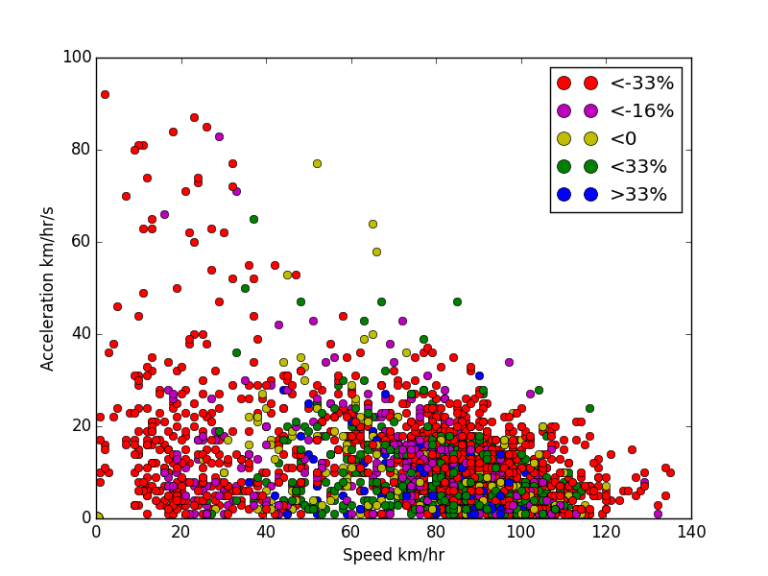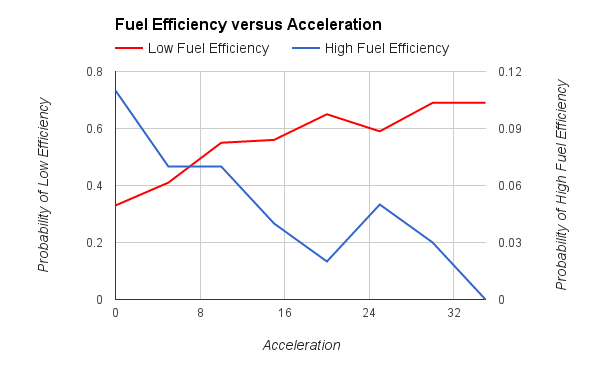In this report, we will analyse the impact of harsh driving on fuel efficiency. A harsh driver uses his brake and accelerator abruptly and regularly. Intuitively, it is obvious that aggressive driving behaviour, like above will impact fuel efficiency negatively. Harsher the driving, worse will be the fuel efficiency. Using the OBD devices installed in our customers vehicles, we decided to objectively verify this.
How to use OBD to analyse aggressive driving
We chose a vehicle that was driven regularly at high speeds. This particular vehicle is driven a lot of time on highways and within cities, so we could collect enough information our our IoT platform from the OBD device connected to this car. We could read several engine parameters from this device as it was being driven. The parameters relevant to this report are the vehicle speed, and Mass Air Flow (MAF) Sensor data. The MAF sensor measure the mass flow rate of air into the combustion engines. The MAF reading is directly proportional to the instantaneous fuel consumption. The data was measured once every 10 seconds and the observation period for this experiment was 3 months.
Fuel consumption versus speed and aggressive driving

The graph above has the magnitude of acceleration versus speed. Since the data is measured at a fixed interval of 10 seconds, the difference in the speeds is proportional to acceleration. Speed of the vehicle is on the X-axis and acceleration on the Y-Axis. Different colored points correspond to different range of fuel efficiencies. The red points correspond to the worst fuel consumption and the blue points to the best. Green, yellow and magenta are intermediate points with decreasing fuel efficiency. From the graph above, we can make the following observations:
- Red dots are more frequent at lower speeds. So, fuel efficiency will be lower at slow speeds. We will analyse speed, gears and its impact on fuel efficiency in a different report.
- Harsher accelerations happen at lower speeds. The driver is more likely to accelerate from 0 to 60 kms/hr, rather than from 80 to 140 kms/hr.
- Lower fuel efficiency points seem correlated with high acceleration
We then delved into the probabilities of the different fuel efficiency points for different ranges of acceleration. First, we split the data by slabs of acceleration – 0-5, 5-10, 10-15 and so on. We then calculated the probability of each color of fuel efficiency for each of these slabs. The data and associated graphs are below.
Table: Probability of different fuel efficiencies of accelerations
| Acceleration | <-33%(red) | <-16%(magenta) | <0%(yellow) | <33%(green) | >33%(blue) |
| 0 | 0.33 | 0.13 | 0.13 | 0.3 | 0.11 |
| 5 | 0.41 | 0.14 | 0.13 | 0.26 | 0.07 |
| 10 | 0.55 | 0.15 | 0.09 | 0.14 | 0.07 |
| 15 | 0.56 | 0.12 | 0.13 | 0.15 | 0.04 |
| 20 | 0.65 | 0.12 | 0.11 | 0.1 | 0.02 |
| 25 | 0.59 | 0.2 | 0.06 | 0.09 | 0.05 |
| 30 | 0.69 | 0.17 | 0.07 | 0.03 | 0.03 |
| 35 | 0.69 | 0.06 | 0.13 | 0.13 | 0 |
Fuel Efficiency versus Acceleration

In the figure above we plotted the probabilities of lowest and highest fuel efficiencies versus acceleration. The table above has the data. From the figure we can see that harsher the acceleration, lower is the probability of high fuel efficiency points (blue). Conversely, the probability of low fuel efficiency (red) increases with harsher acceleration.
So, yes, harsh driving behaviour does and will impact fuel efficiency of your vehicle. Drive safe, save fuel, save money
